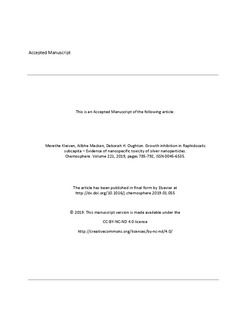| dc.contributor.author | Kleiven, Merethe | |
| dc.contributor.author | Macken, Ailbhe | |
| dc.contributor.author | Oughton, Deborah H | |
| dc.date.accessioned | 2020-01-23T09:00:37Z | |
| dc.date.available | 2020-01-23T09:00:37Z | |
| dc.date.created | 2019-02-26T09:33:58Z | |
| dc.date.issued | 2019 | |
| dc.identifier.citation | Chemosphere. 2019, 221, 785-792. | nb_NO |
| dc.identifier.issn | 0045-6535 | |
| dc.identifier.uri | http://hdl.handle.net/11250/2637584 | |
| dc.description | Embargo until 09 January 2021 | nb_NO |
| dc.description.abstract | Silver, known for its antibacterial properties and for its toxicity to aquatic organisms, is one of the most frequently used nanomaterials and silver nanoparticles can be found in a range of consumer products as well as medical applications. The present study investigated the toxicity of three different silver nanomaterials (Mesosilver (M-Ag), NM300K and NM302) and AgNO3, in the algae Raphidocelis subcapitata. Exposures in the low μg L−1 range were combined with characterization of exposure media to determine whether differences in toxicity could be linked to changes in Ag speciation and/or any nanospecific mechanisms. All tested Ag compounds, except the NM302, reduced growth in the following order AgNO3 ≥ M-Ag > NM300K > NM302 with 50% effect concentrations of 7.09 (3.83–10.52), 9.7 (range not calculated) and 24.18 (15.66–98.16) μg L−1, for AgNO3, Mesosilver and NM300K, respectively. Characterization of exposure media showed that both concentration and time influenced the speciation and stability of Ag in algal test media, regardless of Ag source, and also affected the toxicity to R. subcapitata. In both AgNO3 and Mesosilver exposure the toxicity was correlated with the presence of dissolved Ag species (<10 kDa), however levels of dissolved Ag were too low to account for the observed Mesosilver effects, indicating a nanospecific contribution. Nanospecific toxicity was also observed for NM300K after 24 h of exposure, however the algal population recovered over time, probably due to changes in exposure caused by aggregation of the nanoparticles. | nb_NO |
| dc.language.iso | eng | nb_NO |
| dc.publisher | Elsevier | nb_NO |
| dc.rights | Attribution-NonCommercial-NoDerivatives 4.0 Internasjonal | * |
| dc.rights.uri | http://creativecommons.org/licenses/by-nc-nd/4.0/deed.no | * |
| dc.title | Growth inhibition in Raphidocelis subcapita – Evidence of nanospecific toxicity of silver nanoparticles | nb_NO |
| dc.title.alternative | Growth inhibition in Raphidocelis subcapita – Evidence of nanospecific toxicity of silver nanoparticles | nb_NO |
| dc.type | Journal article | nb_NO |
| dc.type | Peer reviewed | nb_NO |
| dc.description.version | acceptedVersion | nb_NO |
| dc.source.pagenumber | 785-792 | nb_NO |
| dc.source.volume | 221 | nb_NO |
| dc.source.journal | Chemosphere | nb_NO |
| dc.identifier.doi | 10.1016/j.chemosphere.2019.01.055 | |
| dc.identifier.cristin | 1680637 | |
| dc.relation.project | Norges forskningsråd: 221391 | nb_NO |
| cristin.unitcode | 7464,20,19,0 | |
| cristin.unitname | Miljøgifter | |
| cristin.ispublished | true | |
| cristin.fulltext | postprint | |
| cristin.qualitycode | 1 | |

